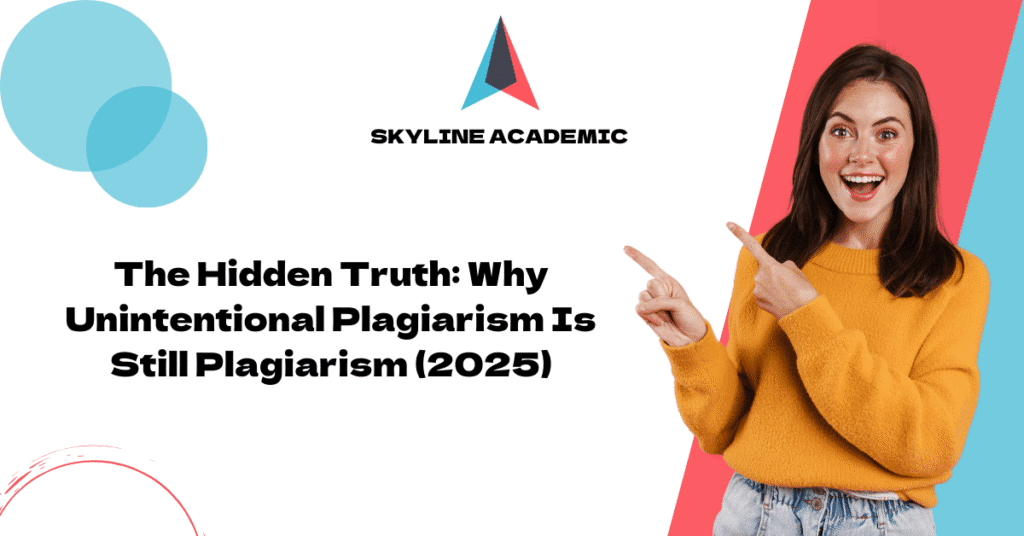The Hidden Truth: Why Unintentional Plagiarism Is Still Plagiarism (2025)
Accidental plagiarism happens more than you think, and it has serious consequences whatever your intent. A survey by Vassileva and Chankova shows that 44% of researchers from major scientific institutions don’t see unintentional plagiarism as a “crime” . But here’s the shocking truth – plagiarism detection tools can’t tell the difference between accidental and intentional copying .
You’ll face the same penalties as someone who copied content on purpose if you forget an idea’s source and present it as your own . The risks of accidental plagiarism are just as severe and must be avoided . You’re responsible for any violation, intended or not . In this piece, you’ll learn ways to avoid plagiarism in your academic work. You’ll understand how detection tools spot these problems and find practical strategies to protect your academic integrity.
What is unintentional plagiarism?
Understanding unintentional plagiarism helps you avoid it. Let’s dive into this concept.
Definition and how it is different from intentional plagiarism
You commit unintentional plagiarism by using someone else’s words, ideas, or research without proper attribution, but not trying to claim them as your own. Intentional plagiarism involves knowingly stealing content. Accidental plagiarism usually happens because of carelessness or unfamiliarity with citation rules.
Students might forget to cite sources, misquote them, or paraphrase too closely to the original text [1]. This is different from intentional plagiarism where someone copies content to take credit for another person’s work [2].
Both types lead to the same result: you present someone else’s intellectual property as your own.
Why intent doesn’t change the outcome
Your motivation makes little difference when determining plagiarism. Academic institutions emphasize that “Lack of intent does not absolve the student of responsibility for plagiarism” [3].
The consequences might vary based on intent, but the act remains plagiarism. Many educators and institutions use a “strict liability” approach—like certain legal principles—where your intentions don’t matter in determining plagiarism [4].
Proving whether plagiarism happened by accident or design becomes almost impossible. One expert points out, “The first explanation for plagiarism is always sloppiness… When the charge is plagiarism, sloppiness is a guilty plea, not an alibi” [5].
Common misconceptions about accidental plagiarism
Students often misunderstand these aspects of unintentional plagiarism:
-
Myth 1: Small instances don’t count as plagiarism. Truth is, there is “no acceptable amount of accidental plagiarism” [1].
-
Myth 2: Changing some words makes it original. Swapping synonyms or reorganizing sentences without citation is still plagiarism [2].
-
Myth 3: Paraphrasing removes citation needs. Original sources need credit even when you rewrite ideas in your own words [2].
-
Myth 4: All plagiarism gets equal punishment. Though all plagiarism is wrong, schools often consider different severity levels for consequences [6].
-
Myth 5: Expulsion happens automatically. First-time unintentional plagiarism rarely ends in expulsion [6].
These misconceptions, once understood, help you handle citation requirements better and maintain academic integrity throughout your academic experience.
Why unintentional plagiarism still matters
Academic institutions don’t take plagiarism lightly—even when it happens by accident. Students often don’t realize how unintentional plagiarism can affect them. The damage goes way beyond the reach and influence of a simple citation mistake.
Impact on academic integrity
Unintentional plagiarism hurts the learning process directly. You miss valuable learning chances when you don’t properly involve yourself with source material. Academic research points out that “The most important repercussion of plagiarism is that you are yourself robbed of the opportunity to learn something” [7].
Your writing and critical thinking skills improve when you properly use other people’s ideas. This happens because you need to develop a deeper understanding of their concepts. The irony is that accidental plagiarism robs you of the chance to boost your academic skills through proper analysis and idea synthesis.
Consequences in research and publishing
Research and publishing raise the stakes dramatically. Publishers and journals use strict screening tools and reject manuscripts with plagiarism—whether intended or not. Here are some eye-opening facts:
- A single retraction can cost institutions up to a million dollars in lost funding, legal fees, and reputation damage [8]
- Journals might retract published papers with plagiarized content, leaving a permanent mark on your reputation [8]
- Disciplinary action from plagiarism can end your job, revoke your degree, and lead to institutional bans [8]
The collateral damage goes beyond institutions. Plagiarism breaks ethical trust and usually leads to professional isolation and lost peer confidence [8].
Institutional policies treat all plagiarism equally
Most academic institutions don’t see any difference between intentional and unintentional plagiarism. Oxford University states it clearly: “Even in cases where the plagiarism is found to have been neither intentional nor reckless, there may still be an academic penalty for poor practice” [9].
So claiming ignorance won’t protect you from plagiarism charges [9]. Many institutions emphasize this point: “Plagiarism, like speeding, is defined by the act — not the intention” [7]. Intent proves almost impossible to determine, so institutions treat nearly all plagiarism cases with equal seriousness [7].
These effects show why proper citation techniques and careful research habits matter—not just for your academic success, but for your entire professional future.
What causes accidental plagiarism?

Image Source: JSK Writes
Careful writers can still make mistakes that lead to accidental plagiarism. A 2018 study revealed that 84.9% of postgraduate students admitted they plagiarized without meaning to because they hadn’t learned proper academic writing skills [10]. Let’s get into what causes this:
Lack of citation knowledge
Writers often don’t know how to cite sources correctly proper citation techniques. This gap in knowledge creates confusion about citations – when they’re needed and how to format them [10]. Students from countries with strong academic backgrounds also find citation rules challenging. Some think facts that are common knowledge don’t need citations [11].
Poor paraphrasing skills
Switching out words or moving sentences around doesn’t count as real paraphrasing. Many people think using different words is enough [12]. Roig’s 1997 study showed this problem clearly—72% of students could spot good paraphrasing, but half of them thought plagiarized versions were fine too [1].
Language barriers and cultural differences
Non-native English speakers face tough challenges when writing academic content. They need to learn English and master field-specific terms and phrases [3]. On top of that, some countries teach students that copying shows respect for authority [3]. This means students from these backgrounds might see intellectual property and giving credit differently.
Time pressure and careless note-taking
The “publish or perish” culture creates stress that affects ethical choices [10]. People who rush often copy text thinking they’ll rewrite it later, but forget to credit sources [10]. Bad note-taking habits are one of the main reasons people plagiarize by accident [13]. Writers lose track of where their ideas came from.
Cryptomnesia: forgetting the source of an idea
Cryptomnesia happens when someone comes up with “a word, an idea, a song, or a solution to a problem” and thinks it’s original [10]. This memory error occurs because our brain uses the same resources for creative thinking and remembering sources [14]. Studies show cryptomnesia shows up in 3-9% of cases in experimental settings, which makes it a common issue [14].
How to avoid plagiarism in your writing

Image Source: Library – American National University
Students can prevent plagiarism by developing good habits and using the right tools. The right strategies will help you keep your work original and properly credited.
Use citation tools and plagiarism checkers
Tools like Turnitin, Grammarly, or SimCheck can identify problems before submission [15]. These detection services compare your text with databases of academic papers and online sources [16]. A plagiarism checker helps you spot potential copying so you can fix it [15]. Check out Skyline Academic Resources for complete citation guides, plagiarism detection tools, and writing assistance to help you maintain academic integrity in your work.
Keep detailed research notes
Your research notes should clearly separate your ideas from others’ work [17]. Document source details right away as you work [2]. Put quotation marks around quoted text in your notes to avoid accidental copying [2]. This simple practice substantially reduces your risk of unintentional plagiarism.
Understand citation styles (APA, MLA, etc.)
Each academic field requires specific citation styles—APA, MLA, or Chicago [18]. Learn your field’s preferred format early [19]. Your assignment guidelines will specify required citation styles [2]. Knowledge of these conventions shows academic rigor.
Ask for help when unsure
You should ask questions rather than risk plagiarism [17]. Reach out to your instructor early if citation requirements confuse you [20]. Writing centers offer valuable guidance about proper attribution methods.
Review institutional academic integrity policies
Students must know their institution’s academic integrity policies [10]. These guidelines define plagiarism and explain what it all means [21]. Knowledge of these rules protects your academic future.
Conclusion
Plagiarism remains a serious academic offense that can damage your future, whether done on purpose or by accident. This piece shows how easy it is to commit unintentional plagiarism and why academic institutions don’t separate based on intent. Your academic reputation relies on proper citation practices, whatever the circumstances.
You can protect your academic integrity through several practical steps. Taking careful notes during research substantially reduces the risk of forgotten sources. It also shows your steadfast dedication to scholarly standards and respect for intellectual property when you master citation styles in your field.
Plagiarism detection tools help you catch accidental mistakes before they become problems. Skyline Academic provides detailed plagiarism detection services that spot potential issues before submission. Their tools check your work against vast databases and highlight passages that need your attention.
Skyline Academic goes beyond detection by offering valuable resources for proper paraphrasing and citation guides. These resources help students tackle complex source material and unfamiliar citation styles. Their academic integrity toolkit gives you the essentials to create original, properly attributed work.
Note that plagiarism can lead to serious penalties – from failed assignments to degree revocation. Strong research habits developed early in your academic career will benefit you long-term. Ask your instructors or writing centers for guidance about citation requirements instead of putting your academic future at risk.
Academic success builds on honest scholarship and proper attribution. You have learned how to avoid the plagiarism traps that catch many students. These strategies, used consistently, will help you develop writing habits that protect your integrity and boost your analytical skills. Proper citation does more than prevent plagiarism – it showcases your scholarly maturity and respect for the academic community.
FAQs
Q1. Is unintentional plagiarism still considered plagiarism?
Yes, unintentional plagiarism is still considered plagiarism. The intent behind the act does not change the outcome. Academic institutions typically treat all forms of plagiarism equally, regardless of whether it was accidental or deliberate.
Q2. What are some common causes of accidental plagiarism?
Common causes of accidental plagiarism include lack of citation knowledge, poor paraphrasing skills, language barriers, time pressure, careless note-taking, and cryptomnesia (forgetting the source of an idea).
Q3. How can I avoid unintentional plagiarism in my writing?
To avoid unintentional plagiarism, use citation tools and plagiarism checkers, keep detailed research notes, understand proper citation styles, ask for help when unsure, and review your institution’s academic integrity policies.
Q4. What are the consequences of unintentional plagiarism?
The consequences of unintentional plagiarism can be serious, ranging from a lower grade on an assignment to disciplinary action. In academic and professional settings, it can damage your reputation and credibility.
Q5. Does a high similarity score on Turnitin always indicate plagiarism?
Not necessarily. A high similarity score on Turnitin doesn’t always indicate plagiarism. It may include properly cited quotes, common phrases, or references. However, it’s important to review the highlighted sections and ensure all sources are properly cited.
References
[1] – https://teachingandlearninginhighered.org/2015/07/20/plagiarism-doesnt-bother-me-at-all-research/
[2] – https://ossja.ucdavis.edu/avoiding-plagiarism-mastering-art-scholarship
[3] – https://ori.hhs.gov/cultural-linguistic-considerations-plagiarism-and-self-plagiarism
[4] – https://www.plagiarismtoday.com/2024/05/06/the-difficult-nuance-of-plagiarism/
[5] – https://stevebuttry.wordpress.com/2016/07/25/intent-doesnt-matter-in-plagiarism-because-no-one-admits-intent/
[6] – https://www.turnitin.com/blog/5-most-common-misconceptions-students-have-about-plagiarism
[7] – https://chss.wwu.edu/sociology/plagiarism
[8] – https://www.proofig.com/post/repercussions-of-plagiarism-in-scientific-research-a-threat-to-integrity-and-innovation
[9] – https://www.ox.ac.uk/students/academic/guidance/skills/plagiarism
[10] – https://www.turnitin.com/blog/accidental-plagiarism-prevention-and-research-excellence
[11] – https://www.myessaywriter.ai/blog/unintentional-plagiarism
[12] – https://www.copyrighted.com/blog/accidental-unintentional-plagiarism
[13] – https://kpu.pressbooks.pub/academicintegrity/chapter/note-taking-skills/
[14] – https://www.apa.org/monitor/feb02/glitch
[15] – https://libguides.snhu.edu/c.php?g=92369&p=3680090
[16] – https://researchguides.uoregon.edu/citing-plagiarism/plagiarism
[17] – https://usingsources.fas.harvard.edu/how-avoid-plagiarism-0
[18] – https://guides.library.upenn.edu/citationpractices/citationstyles
[19] – https://campus.kennesaw.edu/current-students/academics/writing-center/resources/avoiding-plagiarism.php
[20] – https://owl.purdue.edu/owl/avoiding_plagiarism/best_practices.html
[21] – https://www.cuny.edu/about/administration/offices/legal-affairs/policies-resources/academic-integrity-policy/


![Is Cyber Security Hard Expert Guidance Makes It Easy [2025]](https://skylineacademic.com/wp-content/uploads/2025/10/is-cyber-security-hard-expert-guidance-makes-it-easy.png)
